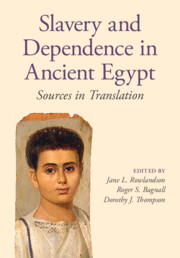Book contents
- Frontmatter
- Contents
- List of illustrations
- List of maps
- List of contributors
- Biographical notice on Jane Rowlandson
- Preface
- List of abbreviations
- Note to the reader
- Aids for the reader
- Glossary of technical terms
- 1 Introduction
- 2 Pharaonic Egypt
- 3 The Late Period
- 4 Jewish perspectives on slavery in Egypt
- 5 Ptolemaic Egypt
- 6 Roman Egypt
- 7 Byzantine and Umayyad Egypt
- Concordance of texts
- Bibliography
- Index
3 - The Late Period
Published online by Cambridge University Press: 01 March 2024
- Frontmatter
- Contents
- List of illustrations
- List of maps
- List of contributors
- Biographical notice on Jane Rowlandson
- Preface
- List of abbreviations
- Note to the reader
- Aids for the reader
- Glossary of technical terms
- 1 Introduction
- 2 Pharaonic Egypt
- 3 The Late Period
- 4 Jewish perspectives on slavery in Egypt
- 5 Ptolemaic Egypt
- 6 Roman Egypt
- 7 Byzantine and Umayyad Egypt
- Concordance of texts
- Bibliography
- Index
Summary
Translated texts preserved on stone, papyrus, leather, and ostraca (pieces of broken pot) in Egyptian and Aramaic illustrate dependence and slavery from the Late Period of pharaonic Egypt, which included over a century of Persian rule. Despite army garrisons and immigrant officials, many earlier Egyptian practices continued. At the same time, under the Persians immigrants brought in practices of slavery from their homeland and, alongside their purchase and sale, the marking of slaves with their owners’ names became well-documented. The terminology of slavery and dependence in both Egyptian and Aramaic texts, new sources for the acquisition of slaves, the relationship of names to ethnicity, and ways in which slaves could gain their freedom are all topics raised in this chapter, as finally is the difficult question of discerning the experience of being a slave.
- Type
- Chapter
- Information
- Slavery and Dependence in Ancient EgyptSources in Translation, pp. 119 - 175Publisher: Cambridge University PressPrint publication year: 2024

